A great reason to check out estate and garage sales. You never know when you’ll find a 1950’s Epiphone Devon archtop for a song!
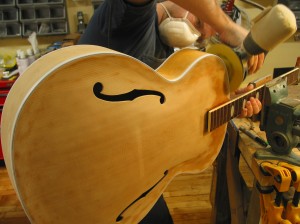
Here’s a project with humble beginnings that grew into a full vintage restoration. The owner picked up this very old Epiphone Devon at an estate sale (along with several other groan-worthy items I won’t even tell you about.) It had been rather sloppily stripped and refinished and the binding had entirely peeled off. Initially, we planned only to add the binding to the body and unfortunately didn’t bother to take pictures. So the photos here begin after the new binding was already in place, when the owner decided he’d like it completely refinished to look like it did originally. It was a good decision.
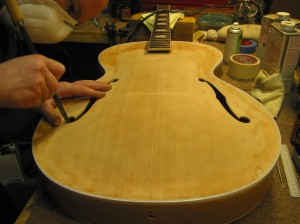
Here, Dan prepares the body for finishing. The previous finish job was topped off with some white paint or nail polish inside the F-holes, an apparent attempt to make the holes look bound. Based on some good photos of a Devon in its original condition, we decided to clean off the white paint and leave them unbound. After sanding away the old shellac or varnish, Dan sprays a sealer coat, taping off the fretboard.
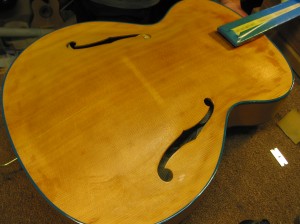
Next comes the sunburst on the top. Below, he scrapes the dark brown finish off the white binding by hand.
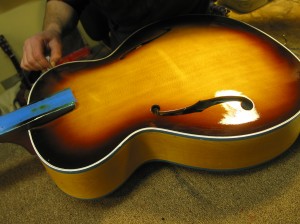
Then full darkening of the back and sides and a vintage amber top-coat.
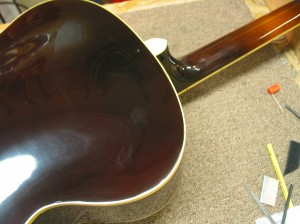
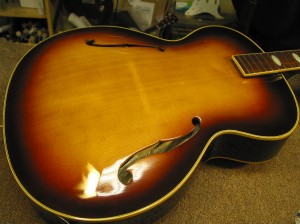
Once finishing is complete, the new binding blends in and looks beautiful.
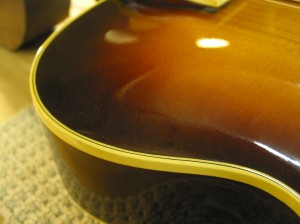
The final product fully assembled.
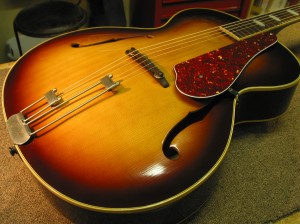
Originally, a Devon would have had a thick and fully-bound tortoise-shell pickguard. Since a hand-made bound guard would have cost $300-400, we opted for a more affordable 3 ply tortoise reproduction. The shape is right and the white middle layer gives a satisfactory illusion of binding.
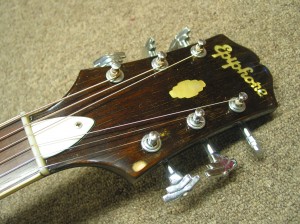
The original tailpiece and bridge and some period tuners made the whole thing look just right. The thin lacquer finish helps bring out this guitar’s full, rich tone. A real beauty.
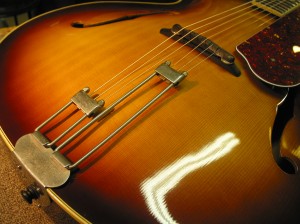

I have a 1954 Devon that I purchased a couple years ago (for $100.00 !). It is in excellent shape structuraly, but the bindings are so old that they have cracked and have pulled away from the body at the ‘hips’ of the guitar. The finish is also very ‘tackey’ during times of high humidity, and shows a good deal of wear (scratches, fading, etc.)
Since I have no intentions in selling this guitar, and am not worried about the ‘petina’, I would love to have it refinished to original new condition.
So, my question to you is, 1)how much am I looking at cost wise to get it refinished, and 20 would you be interested in doing the work ?
Feel free to contact me via e-mail.
Thank You,
Dave Fridley
Dave, I’ll send you an email with more information about pricing.
Hello,
I am re-finishing an Epiphone Devon and I was wondering what size the binding on the sides and neck are.
Thanks, I will appreciate this very much,
Jacob G.
Jacob,
It’s been more than a year since we did the binding work on this so its hard to fully recall. First, we only re-bound the body; the neck binding is original. As best we can recall we used a three-ply combination of thin white (maybe .040″ thick,) a very thin black layer (probably .020″,) and then a medium white layer on the outside (maybe .070.) Part of the equation was – we had a binding channel that was whatever thickness and we needed a three ply look that would fit in that channel (overhanging the outer edge of the body slightly and then trimmed back before finishing.)
Good luck with your repair!
Do you happen to have any of the plans for making the guitar, looking at building something similar myself.
We don’t, no. You might try adapting plans from another archtop design like the Benedetto plans available from Stewart McDonald.
Looking for 1950’s Epiphone Devon tailpiece…
I wish we could be of help Larry. For unique vintage parts like that I usually end up having to go through eBay or Reverb.com. Let me know if you come across a good source of old parts!